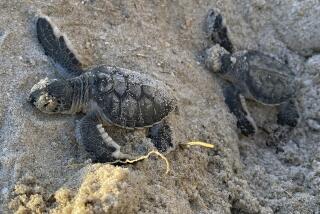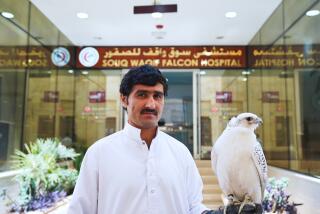Oman’s Turtles in Race With Extinction
- Share via
MUSCAT, Oman — Man, wild dogs and foxes are threatening one of the world’s few remaining nesting turtle populations. U.S. and Dutch zoologists have been summoned to Oman to help save the reptiles that now reach only half their usual 850-pound weight.
“People have been seen riding the turtles up the beach,” said Mahmoud Amour Barwani, director of Oman’s Marine Science and Fisheries Center.
He and other conservationists said thousands of turtle eggs buried in beach sand along Oman’s Arabian Sea coast have been wiped out by tourists lighting fires that inadvertently bake them.
Plastic wrappers are another lethal man-made hazard. The turtles eat them, apparently mistaking them for jellyfish, and kill themselves in the process.
Foxes and wild animals dig up the eggs and eat them as well as pick off hatchlings, scientists said.
Oman, a sultanate at the southern end of the Persian Gulf, is considered an important turtle breeding ground for five species of turtle.
The two most significant are the loggerhead and the green turtle.
Official estimates indicate that about 100,000 turtles nest on Oman’s Masirah Island in the Arabian Sea, making it the world’s biggest loggerhead nesting colony.
About 100,000 green turtles nest at Ras al Hadd on Oman’s easternmost tip.
Barwani said: “Ras al Hadd is now a big tourist draw, and visitors are disrupting nesting.”
The Tourism Department is investigating the effects of tourism on the turtles.
Perran Ross, 38, a zoologist attached to the Massachusetts-based Earthwatch organization, has been called in to work with the government on the protection program.
Working with him is Rod Salm, 40, a Dutch marine zoologist from the Swiss-based International Union for the Conservation of Nature, who said Oman has an important role to play in turtle conservation.
Salm, project leader for the government’s coastal zone management project, said: “In the past, sightings of green turtles weighing 850 pounds were common.
“Today, most turtles seen are about half that weight, a sign that predation by man is having significant effect.
“The balance has been upset. Unless it’s restored, the green turtle could be just another statistic on the growing list of extinct species. Fortunately, Oman is very conservation minded.”
Nesting females emerge from the sea in moonlight to lay up to 100 eggs at a time. But the chances of them hatching and the baby turtles reaching maturity are 1,000 to 1, scientists say.
Evidence of this lies on the beaches, where egg clutches are destroyed or washed out by salt water.
Oman recently banned commercial exploitation of its turtle population and banned trawlers from waters off the main nesting beaches at Ras al Hadd and Masirah.
But Barwani said that man remains a problem.
“People lighting fires on the beaches are a big problem. Apart from inadvertently cooking the eggs, the light of the fires attract hatchlings away from the sea.
“Plastic debris left littered about is also dangerous. Floating in the water, it looks like jellyfish.
“We’re working hard to educate people,” he added. “I don’t believe we should ban tourists but explain to them how to behave.
“It also means persuading fishermen not to disturb nesting beaches and not spread out nets in which hatchlings can be entangled.”
Field teams from the Marine Science and Fisheries Center now make nightly checks of two beaches at Ras al Hadd and four beaches at Masirah.
They count tracks to estimate nesting numbers, measure, weigh and tag turtles and make random egg counts. So far, 23,000 turtles have been tagged.
About 50 of these have been sighted as far away as Ethiopia, India, Pakistan, Kenya and Somalia.
More to Read
Sign up for Essential California
The most important California stories and recommendations in your inbox every morning.
You may occasionally receive promotional content from the Los Angeles Times.










